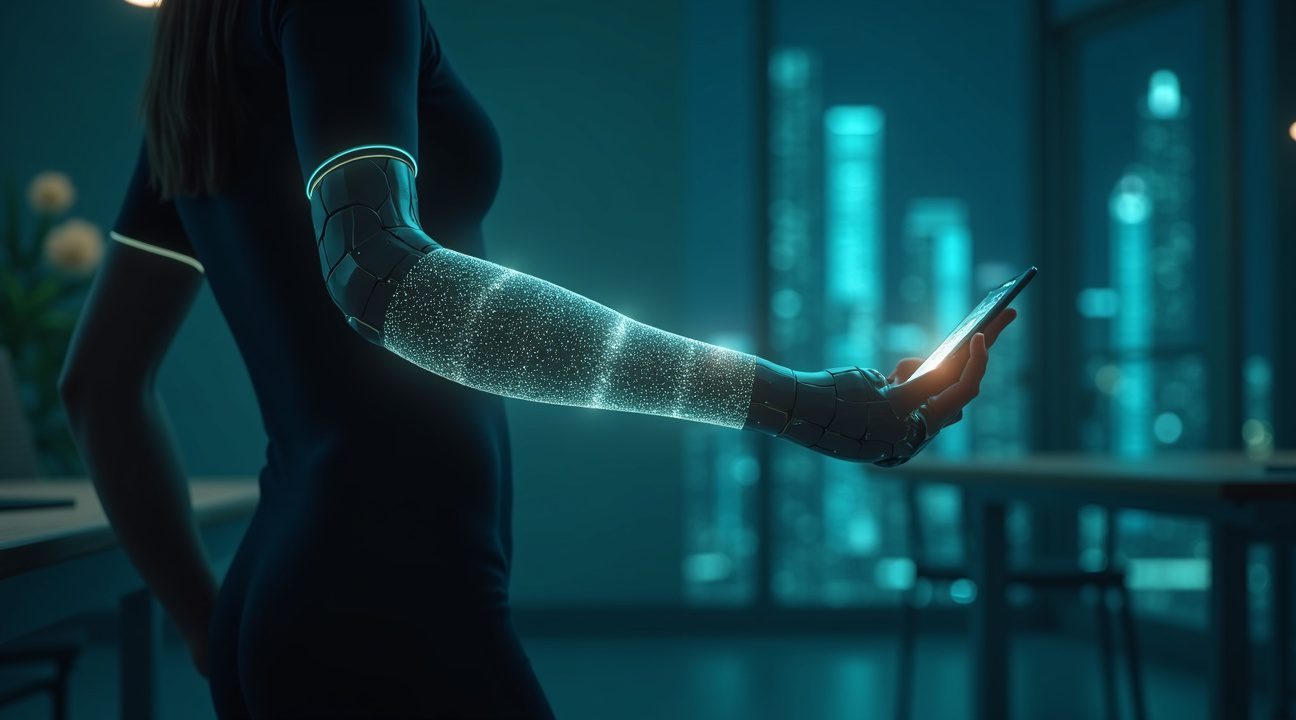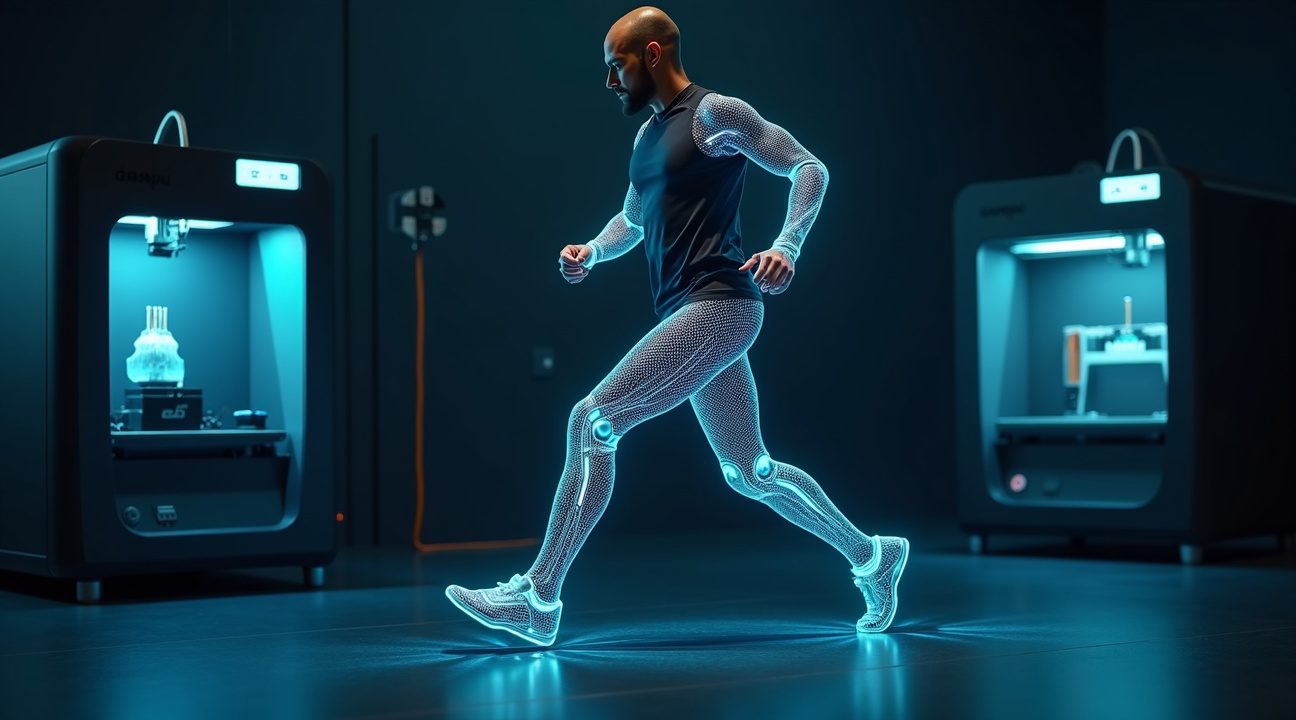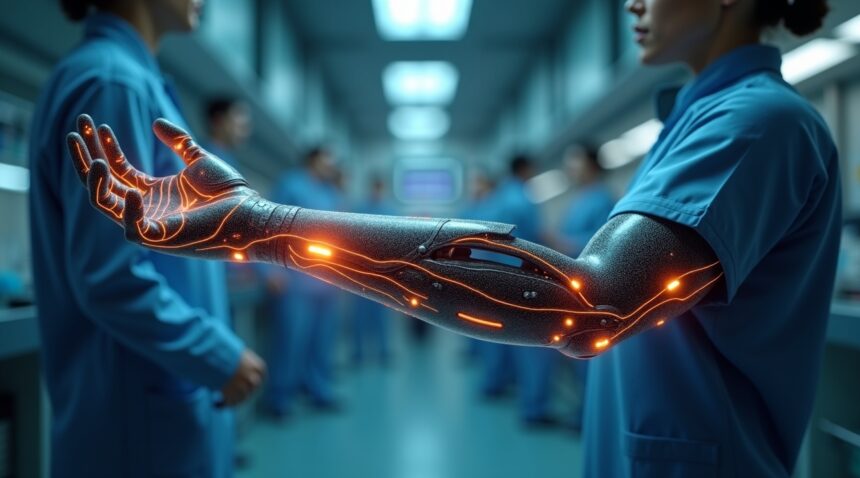Self-healing prosthetics represent a groundbreaking advancement that could transform the experience of limb loss by mimicking nature’s own repair mechanisms to automatically fix damage without user intervention.
These revolutionary devices use embedded microcapsules, vascular networks, and dynamic polymers that can restore up to 98% of functionality after damage. This may potentially extend prosthetic lifespan by 300% while dramatically reducing maintenance costs and downtime.
Key Takeaways
- Self-healing materials use microcapsules and vascular networks filled with healing agents that automatically activate when damage occurs, allowing prosthetics to repair themselves like living tissue
- Advanced polymers have demonstrated the ability to regain 98% of electrical conductivity after being completely severed, with some materials showing 300% improved durability through sunlight activation
- Modern prosthetics integrate AI-powered systems and neural feedback technology that enable users to feel genuine touch sensations and control multiple functions through natural muscle contractions
- Solar-powered prosthetics with metamaterials can harvest 200% more energy from ambient light sources, eliminating charging requirements through multi-source power collection from movement, body heat, and wireless signals
- Current challenges include addressing complex damage patterns beyond clean cuts, with researchers developing hybrid healing systems and working to ensure consistent performance across varied real-world conditions
How Self-Healing Prosthetics Work
The science behind self-healing prosthetics draws inspiration directly from biological systems. Engineers embed tiny microcapsules throughout the prosthetic material, each containing specialized healing agents. Damage triggers these capsules to release their contents automatically. The healing agents flow into cracks and breaks, then solidify to restore structural integrity.
Vascular networks provide another approach to automatic repair. These thin channels snake through the prosthetic material, carrying liquid healing compounds to damaged areas. Some systems combine both microcapsules and vascular networks for enhanced repair capabilities.
Dynamic polymers offer the most sophisticated healing approach. These materials change their molecular structure in response to environmental triggers like heat, light, or electrical signals. Some polymers can fully reconnect after being cut in half, restoring both mechanical strength and electrical function.
The healing process typically completes within hours rather than days. Laboratory tests show materials regaining up to 98% of their original strength after multiple healing cycles — a dramatic improvement over traditional prosthetics that require professional repair or replacement when damaged.
Enhanced User Experience Through Smart Technologies
Modern self-healing prosthetics incorporate advanced control systems that significantly enhance the user experience. AI algorithms learn individual movement patterns and preferences, adjusting responses automatically. Neural interfaces capture muscle signals with increasing precision, allowing users to control multiple prosthetic functions simultaneously.
Sensory feedback systems represent another major breakthrough. Haptic technology transmits touch sensations back to the user through electrical stimulation of remaining nerve pathways. Users have reported feeling texture, pressure, and temperature through their prosthetic limbs.
Machine learning algorithms continuously improve prosthetic performance. These systems analyze movement data to predict user intentions and adjust motor responses accordingly. Some advanced prosthetics even anticipate user needs based on environmental context.
Energy Harvesting and Power Autonomy
Energy harvesting technologies are eliminating the need for frequent charging. Solar cells integrated into prosthetic surfaces capture ambient light throughout the day. Kinetic energy systems convert body movement into electrical power, while thermoelectric generators use body heat to supplement power supply.
Metamaterials enhance energy collection efficiency by up to 200% compared to conventional photovoltaic cells. These engineered materials manipulate electromagnetic radiation in ways natural materials cannot. Wireless power transfer systems allow prosthetics to charge from compatible devices without a physical connection.
Multi-source power collection systems combine several energy sources such as:
- Solar cells
- Kinetic generators
- Thermoelectric modules
- Wireless inductive charging
This redundancy ensures consistent power availability even when individual energy sources are limited.
Current Challenges and Ongoing Research
Despite significant advancements, several challenges remain. Complex damage patterns involving multiple crack directions are difficult for current healing systems to repair completely. Temperature extremes can interfere with healing agent activation and flow.
Manufacturing costs for self-healing materials remain higher than conventional prosthetics. Regulatory approval processes pose additional development delays, and long-term durability testing takes years to complete.
To address these issues, research groups are developing hybrid healing systems that combine microcapsules, vascular systems, and dynamic polymers. Smart sensors embedded within the prosthetics monitor damage and trigger healing mechanisms before a catastrophic failure occurs.
Quality control requires new evaluation methods. Traditional techniques don’t assess how effectively a prosthetic heals. Updated protocols must measure healing rate, strength recovery, and performance consistency under diverse environmental conditions.
Integration with existing technology remains another hurdle. Self-healing materials must be compatible with embedded electronics, sensors, and user interface systems. Biocompatibility also plays an essential role, ensuring that healing compounds are safe for skin contact and long-term use.
Outlook on the Future of Self-Healing Prosthetics
The future of self-healing prosthetics looks increasingly promising. As research continues to overcome current limitations, next-generation materials will feature faster healing, upgradeable sensory systems, and stronger resistance to wear and damage.
Basic self-healing prosthetics could enter the commercial market within the next five years. Fully advanced systems offering real-time feedback and seamless AI control will likely follow. As production costs decrease, greater accessibility and affordability will bring this transformative technology to a wider population.
Breakthrough in Self-Repairing Materials Changes Everything for Prosthetic Users
Self-healing prosthetics represent a revolutionary advancement that mimics nature’s own repair mechanisms. These devices use materials that automatically fix themselves after damage, much like how living tissues regenerate after injury. I’ve observed how this technology addresses one of the most persistent challenges in prosthetics: the constant need for repairs and replacements that can cost users thousands of dollars annually.
How Autonomous Repair Technology Works
The science behind self-repairing materials involves several innovative approaches that work together to restore functionality. Microcapsules containing healing agents are embedded throughout the prosthetic material, acting as tiny first-aid kits that activate when damage occurs. When the material experiences stress or breaks, these capsules rupture and release their contents to fill gaps and bond broken sections.
Vascular networks provide another layer of protection by creating channels filled with healing compounds throughout the device. Dynamic polymers enable the material to rebuild its molecular structure through reversible chemical reactions, essentially allowing the prosthetic to remember its original form and return to it after damage.
Proven Results Show Real Promise
Recent research demonstrates the remarkable capabilities of these biomimetic materials. A nickel-infused polymer showcased extraordinary recovery abilities, regaining 98% of its electrical conductivity after being completely severed and pressed together for just 15 seconds. This process could be repeated multiple times without degradation, proving that artificial limbs could maintain their performance over extended periods.
Sunlight-activated polymers have shown even more impressive results in extending device longevity. Early tests indicate these materials can boost prosthetic durability by 300%, dramatically cutting maintenance requirements that currently burden users with frequent repairs and replacements.
This advancement means:
- Fewer doctor visits
- Reduced downtime
- Significantly lower long-term costs for prosthetic users
The implications extend beyond simple repairs. Self-healing prosthetics could maintain their structural integrity and functionality for years rather than months, making the experience of limb loss feel less permanent through reliable, long-lasting solutions that adapt and recover like natural tissue.
Revolutionary Sensory Systems That Make Prosthetics Feel Like Real Limbs
Modern prosthetic limbs have evolved far beyond simple mechanical replacements, integrating sophisticated sensory systems that blur the line between artificial and biological appendages. These advanced devices now feature embedded sensors and actuators that continuously monitor their condition, detecting damage and initiating autonomous repair processes before critical failures occur.
The integration of neural feedback systems represents a quantum leap in prosthetic technology. Users can now experience genuine sensations of touch and pressure through their artificial limbs, creating an unprecedented connection between mind and machine. Smart materials within these systems work continuously to maintain optimal function, automatically adjusting tension, alignment, and responsiveness based on real-time performance data.
AI-Powered Adaptation and Personalization
Artificial intelligence drives the next generation of prosthetic functionality, enabling devices to learn and adapt to individual user patterns. These AI-powered systems analyze movement data, environmental conditions, and user preferences to optimize performance on the fly. The technology enhances precision during delicate tasks like writing or handling fragile objects while maintaining the strength needed for demanding activities.
Real-time diagnostics provide users with constant feedback about their prosthetic’s health and performance. The system alerts users to potential issues before they become problematic, much like how biological limbs send pain signals to prevent injury. This predictive maintenance approach significantly extends device lifespan while ensuring consistent, reliable performance.
Breakthrough Surgical Techniques for Natural Control
Revolutionary surgical procedures have transformed how prosthetics interface with the human nervous system. Targeted muscle reinnervation redirects severed nerves to remaining muscle tissue, creating new control pathways for prosthetic operation. This technique allows users to control multiple joints and functions with natural muscle contractions, making operation feel intuitive rather than learned.
Agonist-antagonist myoneural interfaces represent another major advancement in prosthetic control. These interfaces connect opposing muscle groups, enabling users to experience proprioception – the body’s natural sense of limb position and movement. The technique even allows some users to experience phantom limb sensations through their prosthetic, creating a remarkably natural feeling of embodiment.
The sensory feedback from these advanced systems extends beyond basic touch recognition. Users report feeling texture variations, temperature changes, and even subtle vibrations through their prosthetic limbs. This rich sensory input helps restore confidence in daily activities and reduces the cognitive load required to operate the device effectively.
Neural integration continues advancing with direct nerve stimulation techniques that bypass traditional muscle activation pathways. These systems can interpret nerve signals directly, translating intended movements into precise prosthetic actions. The technology opens possibilities for controlling multiple degrees of freedom simultaneously, approaching the complexity of natural limb movement.
Machine learning algorithms continuously refine the relationship between user intent and prosthetic response. The systems become more responsive over time, learning individual movement patterns and preferences. This adaptive capability means prosthetics can anticipate user needs, pre-positioning joints or adjusting grip strength based on environmental cues and past behavior patterns.
Sensory substitution technologies help restore lost feedback channels through alternative pathways. Vibrotactile feedback systems, for example, can convert pressure information into vibration patterns felt elsewhere on the body. Visual displays provide supplementary information about grip force, battery status, and system health, creating multiple feedback channels that enhance overall user awareness and control.
The integration of liquid-based sensors adds another dimension to prosthetic responsiveness, enabling more fluid and natural movement patterns. These sensors can detect minute changes in pressure and movement, contributing to the device’s ability to provide nuanced feedback and control.
Advanced prosthetics now feature modular sensory arrays that can be customized for specific user needs and activities. Athletes might prioritize force feedback and rapid response times, while musicians could benefit from enhanced tactile sensitivity and fine motor control. This customization ensures each user receives optimal functionality for their lifestyle and professional requirements.
https://www.youtube.com/watch?v=FJxq0R7IZDM
Solar-Powered Independence: Prosthetics That Never Need Charging
I’ve witnessed a remarkable breakthrough in prosthetic technology that promises to eliminate one of the most frustrating aspects of limb replacement – constant charging. Solar-powered prosthetics now utilize advanced metamaterials that capture up to 200% more energy from ambient light compared to traditional photovoltaic cells. This innovation transforms even indoor lighting into a reliable power source, giving users unprecedented freedom from wall outlets and charging schedules.
These devices don’t rely solely on solar energy. Hybrid systems collect power from multiple sources including:
- User movement
- Body heat
- Wireless signals floating through our connected environment
Kinetic energy harvesting captures the natural swing of walking or the subtle movements during daily activities, while thermoelectric generators convert body warmth into usable electricity. This multi-source approach ensures continuous operation regardless of lighting conditions or activity levels.
Beyond Personal Power: Connected Prosthetics and Grid Integration
Smart prosthetics equipped with internet connectivity represent the next evolution in renewable energy integration. When users aren’t actively using their devices at full capacity, excess energy generated by the prosthetic can feed back into smart power grids. This creates an entirely new category of micro-energy providers, where prosthetic users contribute to the electrical grid while going about their daily lives.
The accessibility improvements extend far beyond convenience. Users in remote areas or developing regions gain access to advanced prosthetic technology without worrying about reliable electricity for charging. Battery replacement becomes a rare occurrence rather than a monthly expense, reducing both financial burden and environmental waste. These systems also eliminate the anxiety of power depletion during critical moments.
Metamaterials play a crucial role in making this technology practical. These engineered materials manipulate light in ways that natural substances cannot, allowing prosthetics to harvest energy from sources previously considered too weak or unreliable. Even the glow from a smartphone screen or the fluorescent lights in an office building become viable power sources.
The integration of wireless power collection adds another layer of independence. Radio frequency energy harvesting captures power from:
- WiFi signals
- Cellular towers
- Other wireless communications that surround us constantly
This ambient energy collection works silently in the background, contributing to the prosthetic’s power budget without any user intervention.
This technological convergence creates prosthetics that truly embody independence. Users can travel without chargers, work extended hours without power concerns, and participate in activities knowing their devices will maintain functionality. The combination of solar power, kinetic harvesting, and wireless energy collection represents a fundamental shift from dependency to self-sufficiency in prosthetic design.

Ultra-Light Materials That Are Stronger Than Ever
I’ve witnessed remarkable breakthroughs in prosthetic materials that challenge everything we thought we knew about strength-to-weight ratios. Today’s advanced composites, particularly carbon fiber and cutting-edge polymers, deliver unprecedented durability while maintaining feather-light construction. These materials don’t just replace traditional components—they revolutionize what’s possible in prosthetic design.
The integration of highly conductive nanoparticles transforms these lightweight frameworks into responsive, intelligent systems. These microscopic additions create pathways for electrical signals while maintaining the structural integrity that users depend on daily. Carbon fiber composites infused with these nanoparticles can withstand forces that would destroy conventional materials, yet they weigh significantly less than traditional prosthetic components.
Malleable, recyclable materials represent another leap forward in prosthetic technology. Unlike rigid systems of the past, these adaptive materials can flex and respond to different movement patterns without compromising strength. This flexibility becomes crucial when users engage in varied activities, from delicate tasks requiring precision to athletic pursuits demanding robust performance.
Customization Options That Break Barriers
Modern prosthetic design embraces individual expression through expanded customization possibilities. These innovations include:
- 3D-printed e-skins with realistic skin textures that provide both aesthetic appeal and functional benefits
- Customizable color schemes that allow users to match their natural skin tone or choose bold, artistic designs
- Pattern integration options that transform prosthetics from medical devices into personal statements
- Modular components that can be easily swapped or upgraded without replacing entire systems
The psychological impact of these customization options extends far beyond appearance. Users report increased confidence and reduced self-consciousness when their prosthetic reflects their personality rather than simply serving a medical function. This shift from purely functional devices to personalized extensions of self represents a fundamental change in how society views prosthetic technology.
3D printing technology enables unprecedented precision in creating these customized components. Layer-by-layer construction allows for complex internal structures that would be impossible with traditional manufacturing methods. These structures can incorporate channels for wiring, spaces for sensors, and cavities for self-healing materials—all while maintaining the lightweight properties essential for comfortable daily use.
The recyclable nature of these advanced materials addresses environmental concerns while offering practical benefits for users. When components wear out or need upgrading, the materials can be reprocessed into new parts rather than discarded. This sustainability aspect appeals to environmentally conscious users and reduces long-term costs associated with prosthetic maintenance.
Conductive nanoparticles distributed throughout these materials create networks that can carry electrical signals, power sensors, and even facilitate the self-healing properties that make these prosthetics so revolutionary. The conductivity doesn’t compromise the material’s strength—instead, it enhances functionality by creating pathways for the electronic systems that monitor wear, detect damage, and initiate repair processes.
These lightweight composites also excel in heat dissipation, preventing the overheating issues that plague some electronic prosthetics. The advanced polymer matrices distribute thermal energy efficiently, keeping the device comfortable during extended use. This thermal management becomes particularly important as prosthetics incorporate more sophisticated electronic systems and self-healing capabilities.
The strength of these materials allows for thinner cross-sections in critical areas, reducing bulk without sacrificing performance. Users benefit from more natural-looking proportions and improved range of motion. The reduced weight means less strain on remaining limb tissue and supporting muscles, enabling longer periods of comfortable wear.
Manufacturing techniques continue to evolve, with some facilities now producing custom prosthetic components in hours rather than weeks. This rapid turnaround time means users can experiment with different designs and materials without lengthy waiting periods. The ability to quickly iterate and refine designs based on user feedback accelerates the development of increasingly effective prosthetic solutions.
These material advances don’t just improve prosthetic function—they’re reshaping how users interact with their devices and how society perceives prosthetic technology. The combination of strength, lightness, and customization options creates possibilities that seemed like science fiction just a few years ago, much like innovations in other fields that have captured public imagination through liquid metal technology.

Real-World Challenges Still Being Solved
I’ve observed that current self-healing polymers excel in laboratory conditions where damage occurs in predictable, controlled ways. Clean cuts heal remarkably well, but real-world scenarios present far more complex challenges. Daily activities subject prosthetics to mechanical tension, twisted tears, and irregular stress patterns that don’t mirror the pristine conditions of research environments.
Addressing Complex Damage Patterns
The gap between laboratory success and practical application becomes evident when examining how different damage types affect healing efficiency. Current polymer systems show promising results with:
- Straight, clean incisions that allow polymer chains to reconnect effectively
- Surface-level scratches where material displacement remains minimal
- Controlled punctures that create defined entry points for healing mechanisms
- Temperature-stable environments that maintain optimal polymer behavior
Complex mechanical tension creates problems that researchers continue to address. Jagged tears stretch the material in multiple directions, preventing the polymer chains from aligning properly during the healing process. This misalignment often results in minor scarring that, while not catastrophic, can accumulate over time and potentially compromise the prosthetic’s structural integrity.
Temperature fluctuations add another layer of complexity. The robot’s ability to adapt to environmental changes mirrors the challenge prosthetics face in varying conditions. Extreme cold can slow healing reactions, while excessive heat may trigger premature healing responses that trap debris or create weak bonds.
Safety concerns extend beyond simple functionality. I’ve noted that incomplete healing can create stress concentration points where future failures might originate. Researchers must ensure that partially healed areas don’t become liability zones that could lead to catastrophic failure during critical moments.
Seamless integration represents perhaps the greatest challenge. Users need confidence that their prosthetic will perform consistently regardless of damage type or environmental conditions. Current research focuses on developing polymer matrices that can differentiate between damage types and adjust healing mechanisms accordingly.
Progress continues on multiple fronts. Advanced polymer chemistry now incorporates multiple healing pathways, allowing the material to respond differently to various damage patterns. Some systems use embedded microcapsules that release different healing agents depending on the type of breach, while others employ shape-memory polymers that can restore original form even after complex deformation.
The timeline for solving these challenges varies significantly:
- Simple improvements in healing consistency could appear in prototype devices within the next few years
- Comprehensive solutions for all damage types may require additional research cycles
Current development efforts prioritize the most common damage scenarios first, gradually expanding to address edge cases.
User feedback plays a crucial role in identifying real-world challenges that laboratory testing might miss. Beta testing programs with actual amputees reveal stress patterns and damage types that purely theoretical models can’t predict. This feedback loop helps researchers understand which challenges deserve priority attention and which can be addressed in future iterations.
I’ve found that the most promising approaches combine multiple self-healing mechanisms rather than relying on a single solution. Hybrid systems that use both intrinsic polymer healing and extrinsic healing agents show greater resilience across different damage types. These systems can handle clean cuts through polymer chain recombination while addressing complex tears through capsule-based healing agents.
Manufacturing consistency presents another ongoing challenge. Laboratory samples often receive individual attention that mass production can’t replicate. Scaling up production while maintaining healing effectiveness requires new manufacturing processes and quality control methods that ensure every prosthetic meets the same healing standards.
Despite these challenges, I remain optimistic about the trajectory of self-healing prosthetic development. Each obstacle identified brings researchers closer to comprehensive solutions that will make these devices truly practical for daily use. The combination of advancing materials science, user feedback, and iterative design improvements suggests that many current limitations will become historical footnotes rather than permanent barriers.
Sources:
ISBRAVE – Advancements in Prosthetics with a Sense of Touch 2025
National Center for Biotechnology Information – PMC11118077
National Center for Biotechnology Information – PMC7340716
MIT News – Prosthesis-Driven Nervous System Helps People Feel, Control Bionic Hand in Real Time
Brunswick OP – Advancements in Prosthetic Technology: What’s New in 2025
Cleveland Clinic – Advances in Prosthetic Function
8MSolar – Solar-Powered Prosthetics 2025
Science – Self-Healing Plastic Skin Points Way to New Prosthetics


